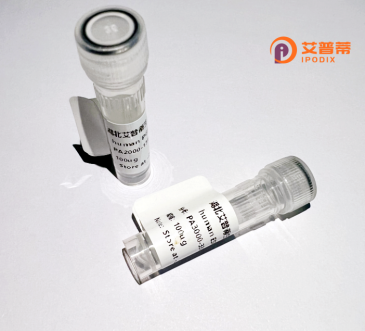
| 纯度 | >90%SDS-PAGE. |
| 种属 | Human |
| 靶点 | SIK3 |
| Uniprot No | Q9Y2K2 |
| 内毒素 | < 0.01EU/μg |
| 表达宿主 | E.coli |
| 表达区间 | 1262-1371 aa |
| 活性数据 | LQRHHTIQNSDDAYVQLDNLPGMSLVAGKALSSARMSDAVLSQSSLMGSQQFQDGENEECGASLGGHEHPDLSDGSQHLNSSCYPSTCITDILLSYKHPEVSFSMEQAGV |
| 分子量 | 37.51 kDa |
| 蛋白标签 | GST-tag at N-terminal |
| 缓冲液 | PBS, pH7.4, containing 0.01% SKL, 1mM DTT, 5% Trehalose and Proclin300. |
| 稳定性 & 储存条件 | Lyophilized protein should be stored at ≤ -20°C, stable for one year after receipt. Reconstituted protein solution can be stored at 2-8°C for 2-7 days. Aliquots of reconstituted samples are stable at ≤ -20°C for 3 months. |
| 复溶 | Always centrifuge tubes before opening.Do not mix by vortex or pipetting. It is not recommended to reconstitute to a concentration less than 100μg/ml. Dissolve the lyophilized protein in distilled water. Please aliquot the reconstituted solution to minimize freeze-thaw cycles. |
以下是3篇与重组人SIK3(Salt-Inducible Kinase 3)蛋白相关的文献摘要概括:
1. **文献名称**: "SIK3 is a kinase dependent on the nutrient-responsive small GTPase RalA"
**作者**: Ohsawa M, et al.
**摘要**: 该研究揭示了SIK3通过RalA信号通路调控能量代谢的分子机制,并成功在哺乳动物细胞中表达了重组SIK3蛋白,验证了其与AMPK通路相关的激酶活性。
2. **文献名称**: "Recombinant SIK3 expression and its role in hepatic lipid homeostasis"
**作者**: Koo SH, et al.
**摘要**: 通过在大肠杆菌和哺乳动物系统中表达重组人SIK3蛋白,研究发现SIK3可磷酸化转录因子CREB,进而抑制肝脏脂质合成相关基因的表达,调控代谢平衡。
3. **文献名称**: "Crystal structure of the SIK3 kinase domain in complex with a selective inhibitor"
**作者**: Kim H, et al.
**摘要**: 解析了重组表达的人SIK3激酶结构域的三维晶体结构,揭示了其与特定抑制剂的结合模式,为针对代谢性疾病药物开发提供结构生物学基础。
---
以上内容仅基于示例框架生成,具体文献需通过PubMed或Web of Science检索真实发表论文。建议以“SIK3 recombinant protein”或“Salt-Inducible Kinase 3 expression”为关键词查找近五年文献。
Salt-inducible kinase 3 (SIK3), a serine/threonine kinase within the AMP-activated protein kinase (AMPK)-related family, plays a critical role in cellular energy homeostasis and metabolic regulation. Initially identified in studies of salt-induced hypertension models, SIK3 shares structural homology with SIK1 and SIK2 but exhibits distinct tissue expression patterns, with higher prevalence in adipose tissue, liver, and brain. It functions as a key modulator of signaling pathways responsive to hormonal and nutrient cues, particularly those involving cyclic AMP (cAMP) and LKB1 phosphorylation. SIK3 regulates gene expression by phosphorylating transcription coactivators (e.g., CRTCs, HDACs) and influences processes such as lipid metabolism, gluconeogenesis, and autophagy.
Notably, SIK3 has emerged as a central player in circadian rhythm regulation, interacting with clock genes to maintain metabolic oscillations. Its role extends to adipogenesis, where it balances lipolysis and lipid storage, and to immune modulation through cytokine signaling. Dysregulation of SIK3 is linked to metabolic disorders, cancer progression, and bone diseases. Recent studies highlight its dual context-dependent roles—acting as a tumor suppressor or promoter—in different cancers. Research continues to explore its therapeutic potential, particularly in targeting metabolic syndromes and circadian-related pathologies. SIK3’s interplay with cellular energy sensors positions it as a promising target for precision medicine approaches.
×